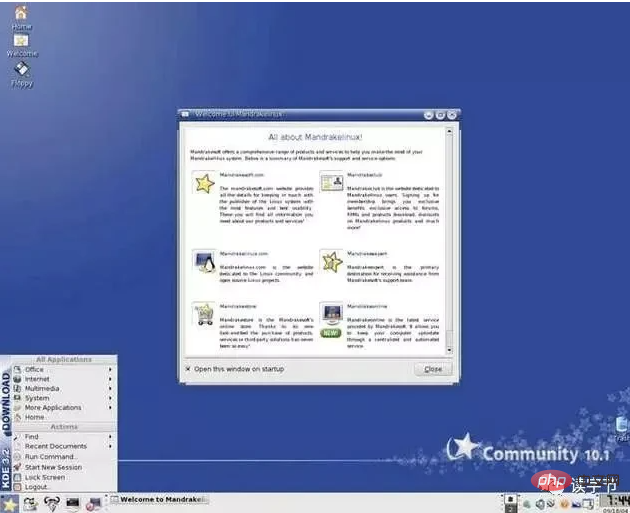I started playing Linux in my dormitory when I was in college in 2000. It’s been 20 years now! They are also among the first batch of users obsessed with Linux desktop! I remember that the BBS forum development for my graduation project at that time was completed on Mandrake Linux (later renamed Mandriva, a desktop-oriented software inherited from the Redhat system). In order to download three 700M iso images, I took the hard drive to the Internet cafe and played downloading all night , it’s wonderful to think about it now!

The first Linux fans were all looking forward to the desktop development of Linux. I was also a frequent visitor to Linuxsir and a moderator at that time, as well as Linux fans. Linuxedeu, Linuxaid, I wonder if Linux geeks who once loved this sky can see it!
Let’s get down to business! As for whether the development of Linux desktop is hindered by the fact that Goose Factory does not actively develop the Linux version of QQ, to be honest, it has an impact, but it is exaggerated!
The closing farewell letter from the author of Tsinghua Luma QQ can tell how out of tune the commercial companies at that time were with the open source community. But isn’t the desktop side of Linux developing well up to now? It has not disappeared from the long history of history, and the desktop is becoming more and more mature. On the other hand, server-side development has basically dominated the world!
If you want to understand the development of Linux, you must look at its original intentions, and you cannot blame an application manufacturer. First of all, Linux is just a kernel. At that time, the GNU open source organization lacked a good kernel, so it joined forces with Linux. With the support of GUN's huge operating system software library, the Linux distribution quickly became popular. Unfortunately, At that time, Freebsd was fighting a lawsuit with major Unix manufacturers to change the code due to copyright, which delayed it for several years. Otherwise, we still don’t know who will win now!
Secondly, since Linux joins forces with GNU, it must follow the GPL agreement. The GPL agreement has a strong contagion of open source code. The first person to be infected must be the driver manufacturer. The driver must be open source. This is a lot. The biggest culprit that hindered the development of Linux in 2016 is actually driver manufacturers. It is not that they are unwilling to develop official Linux drivers, but because this will open up the manufacturers' driver designs and affect market competition, thus causing a large number of PCs to be unable to use Linux normally.
So Google of Android has done something that is disgraceful to the open source community, but a great thing to the world, that is, Android is based on the Linux system, but bypasses GPL agreement, driver manufacturers can safely support Android.
Finally, there is the issue of business model. This actually hinders the development of Linux desktop. Server-side open source software has begun to reach a very mature stage. For example, Redhat was sold to IBM for tens of billions, but there is still a long way to go to become a desktop Linux publisher. The desktop side is not as good as the server side, because the operation of the server side can control the fragmentation of releases and versions, and does not require too many external ecological dependencies, so that it can do things safely.
But the desktop side is not good. KDE and Gnome are simply not enough. As long as you use the Linux desktop, you must first look for similar Win application software under Linux. This is not just as simple as looking for QQ software. , the key point is that even if you find an application software that can be used in the Linux version, there will still be a lot of application problems, such as: whether the font is correct, whether the interface is garbled, whether the content format matches, etc. This is actually the most frustrating thing. things.
In fact, these problems are caused by too many Linux distributions, and the iteration frequency of each library version is too fast. This makes it easy for the underlying library to update the version, and the upper desktop application cannot match it, so it cannot be installed. The problem of not being able to use it. In this situation, the number of Linux users will definitely not increase, and it will be difficult to commercialize the Linux desktop. The harder it is, the less likely it is to attract popular applications, which in turn becomes a constraint on the number of users.
Even in this situation, the Linux desktop is still moving forward, and it is still doing well. In fact, this is the issue that should be discussed most, because it does not conform to normal logic. Look at BlackBerry, Nokia, and Microsoft. Without the support of the application ecosystem, mobile OSs have disappeared one by one, but the Linux desktop has not, and it is still going its own way. This is the power and greatness of Linux, as if it is a mountain, always right in front of you, just You just don't see it sometimes, and whether people with various ideas need to go up the mountain is just their own wishful thinking.
I really don’t know how the Linux desktop is going, but what I see is that Microsoft, once the enemy of the open source community, has begun to embrace Linux, not just the server, but the entire .net desktop development The environment is starting to support Linux, and even my own operating system wants to change to Linux. With such firm support from basic platform vendors, I think it is highly likely that other commercial vendors will support it sooner or later. The standardization of the Unix family of operating systems is really not a strategy, but a trend.
Recommended: "linux video tutorial"

































![[Web front-end] Node.js quick start](https://img.php.cn/upload/course/000/000/067/662b5d34ba7c0227.png)



